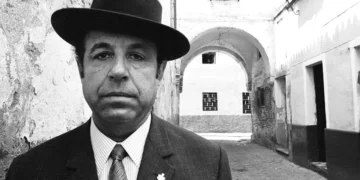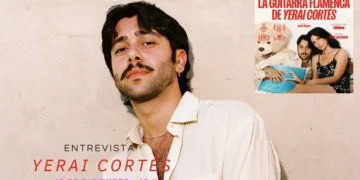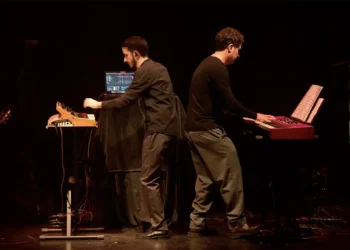|
| Coverage of the Festival Flamenco USA is sponsored by Arte Fyl Dance Shoes |
| Calzados de Arte Fyl: art for the Art Professionals know |
Text : Mona Molarsky
White nightgowns, kudos for the
messenger, mixed feelings about the message
Dancers: Eva Yerbabuena, Mercedes de Córdoba, Asunción
Pérez, María Morena, Sonia Poveda, Luis Miguel González,
Amador Rojas, Eduardo Guerrero, Juan Manuel Zurano. Musicians: Marta
de Castro, soprano. Pepe de Pura, Enrique Soto, vocal. Paco Jarana,
guitar. Antonio Coronel, percussion. Ignacio Vidaechea, saxophone,
flute. Rafael de Utrera, vocal. Choreography & Direction: Eva
Yerbabuena. Choreography (guest): Javier Latorre. Direction: Hansel
Cereza. Music: Paco Jarana. Adaptation of popular lyrics: Arcángel,
Segundo Falcón. Lighting: Raúl Perotti. Produced by
Eva Yerbabuena, S.L.. Raquel Domínguez, wardrobe.
Any modern person who falls in love with flamenco must have moments
when they feel split down the middle. There are those nights when
the insistent notes of a guitar and the singer's elemental voice
transport you to a realm as ancient and mysterious as Stonehenge.
And then there are those mornings, when, grabbing your cell phone,
and checking your watch as you rush for a train, you are convinced
that you have been seduced by an absurd vision. In the clear light
of day, it is suddenly so obvious that flamenco has nothing,
absolutely nothing to do with modern life, as you know it.
Seesawing between these two experiences is enough to make anyone
schizophrenic.

it must be with Eva Yerbabuena, whose flamenco ballet, 5 Women
5 seems at once to embrace flamenco and deconstruct it. Did
she consciously intend it as a deconstructionist piece, or is it
simply the outgrowth of a deeper splintering? It's hard to say.
Her controversial work, which has won both praise and scorn in Europe,
had its New York City premiere to a sold out house at the City Center
Theater on Sunday, January 30th. Judging by the audience's final
warm applause, it would seem that Yerbabuena's stage presence and
exceptional talent largely overcame any doubts the public might
have had about the work's choreography and content.
The City Center's famous red curtain was already raised on a dark
stage, when the New York audience filed into the theater, chatting
and exchanging kisses with old friends. Suddenly, the house lights
went down and the chatter hushed. Two female figures and an upholstered,
white chair were spotlighted on stage. Then, just as suddenly, the
scene went black. Far off, the stomping of heels could be heard,
and as its volume increased, a strobe light caught fragments of
figures moving across a plane. The vignette was punctuated with
a black silence. Next: the image of a woman in white, sitting on
a chair under the spotlight, and a line of white-gowned women, posed
like statues, while a soprano's high, angelic voice soared over
their heads. The women began to walk, taking the slow, calculated
steps of modern dancers, until they formed a line facing the audience.
Then Paco Jarana's guitar kicked in, and the women glided, slowly,
majestically, into a sort of modernist pavane.
It’s suddenly obvious that flamenco
has nothing, absolutely nothing to do with modern life, as you know
it.
The flamenco ballet had begun. Or so one might expect. But there
was something slightly off, even from the start. First, there were
those dumpy, unconstructed white gowns, worn by Yerbabuena and the
women in her company. If the show were being performed at an outdoor
flamenco festival in Spain, the old grandmothers sitting on folding
chairs near the back would have been whispering, «Aye,
Matilde, what are those girls wearing? I think they're
in their underwear!» «No, Eulalia, those are nightgowns.
It's the latest thing!» But, shhhh! Back there! Stop the
gossip and let the show go on!
Like the women, the male members of the company were dressed in
white: white pants, white jackets and loose white shirts. While
the women suggested muses in sleepwear, the men conjured up sailors
from Caribbean ports. Both groups moved with a perfect, soulless
precision that allowed for no individuality–a flamenco version
of the corps du ballet in traditional ballet blanc.
Yerbabuena's musicians were one of the production's strengths.
Paco Jarana's guitar could be traditionally rhythmic and lyrical,
or jazzy and up-to-the minute. Antonio Coronel on percussion and
Ignacio Vidacchea on flute and saxphone added bright notes to the
fusion elements that are currently so de rigueur. But it
was the strong singing, most notably by Rafael de Utrera and Enrique
Soto (from the great Sordera clan of Jerez), that grounded
the show within a tradition and gave it emotional weight. If only
they'd had more to work with. In keeping with the program's fragmented
esthetic, classic flamenco forms–a soleá apola-caña
and a minera, for example–were jammed up against free
form riffs and sometimes shattered beyond recognition. «Was
that the minera?» a disgruntled flamenca
sitting next to me whispered, at one point, «I would never
have guessed!»
Yerbabuena used her company as a unit, moving the dancers across
the stage in jazzy architectural blocks, arms raised over heads,
hands rotating or fingers snapping–choreographic clichés
that may have been fresh on Broadway at the birth of West Side
Story but reached their flashy apogee in the nineteen-nineties,
with the Las Vegas-style choreography of Joaquín Cortés.
Like a rag doll on a string…animated
by another power, helpless to still her feet.

something different seemed to be happening here. While her company
moved in perfect, Busby-Berkeley unison, Yerbabuena fell out of
sync. She staggered, started to fall, clutched her head in consternation.
Later, she fell to the floor, got herself up, back into compás,
then stumbled again.
She seemed exhausted, barely able go on. Yet, still she kept dancing,
forced on by the propulsive rhythms of the guitar, drums and palmeros.
Like a rag doll on a string–she appeared animated by another power,
helpless to still her feet. An updated version of the girl in The
Red Shoes, Yerbabuena seemed doomed to dance herself to death.
In the back of my mind, I heard the chorus of little grandmothers
on their folding chairs. «Aye, Matilde! What's happening
to the chica?» «I don't know, Eulalia, maybe
she's sick!» «Sick? No, she's been drugged! One
of those bad flamenco boys dropped something into her café
con leche, just before the show!»
What was happening indeed? I spent the next half-hour
pondering the question, as Yerbabuena danced her way through a breakdown
of epic proportions. This was something different and bigger than
the traditional theatrical heartbreaks of love and death. Flamenco,
of course, has its own vocabulary for expressing loneliness, pain
and grief. When it comes to these emotions, flamenco may well be
the most expressive language on earth. Yet Yerbabuena wasn't speaking
flamenco at all. Instead, she seemed to have rejected all
dance idioms. It appeared that she was falling apart, right there
in front of us, on stage.
As her four male dancers executed yet another round of masculine
lunges and turns, a theory took shape in my head. Perhaps our heroine
was suffering from an excess of machismo surrounding her
in the society at large. It was overpowering and all-encompassing,
something she couldn't escape from, a giant wave pulling her under–only
to fling her up again, mercilessly, on the sand. And, if this were
the case, what a terrible situation for a flamenco woman to be in.
Betrayed by her world, her artistic language, her own tradition.
Different and bigger than the traditional
theatrical heartbreaks of love and death.
Then again, maybe it wasn't machismo that had knocked the diminutive
Yerbabuena down, but the strange, harsh disjunction between the
flamenco life and our clock-driven, electronic world. The shock,
perhaps, had coalesced for her into a kind of poisonous acid. As
we watched, the invisible fluid was creeping across the floorboards
of the stage, seeping into the leather of her beautifully-crafted
shoes, coursing through her blood stream, forcing her on and on
with this dance of St. Vitus.
«Aye, Matilde! The things young people suffer through
these days. They've got problems with names we've never even heard
of! No, I wouldn't be young again for a million euros.»
There was another blackout. A disembodied voice spoke lines of
poetry. Then Yerbabuena appeared center stage, in a pool of light,
her footwork a delicate zapateado that slowly gained in
urgency. Men in satin-trimmed jackets and women in satin aprons
moved upstage and down, in perfect compás, falling
into poses, assuming the required attitudes. Yerbabuena was in perfect
compás too, but she acted like she had been stabbed.
She staggered and tottered backward. Men and women grabbed at her,
but she pushed them away. Suddenly, a hoarse and piercing, «Nooooooo!»
was wrenched from her throat, bringing everything to a stop. In
the moment of silence that followed, Yerbabuena walked off stage.
The guitars and percussion launched into a bossa nova-inflected
fantasy that morphed into tangos. Within minutes, she was back in
the center spotlight, dressed in black with a bolero jacket, trimmed
in gold. An amazing and inexplicable transformation seemed to have
taken place. As she pulled her small figure to its full height and
stood, looking up into the lights, Yerbabuena appeared at once vulnerable
and steely. And it seemed to me that for one fleeting moment, the
memory of Carmen Amaya glided, like the shadow of an eagle, across
the stage.
The strange, harsh disjunction between
the flamenco life and our clock-driven, electronic world.
So began Yerbabuena's seguiriya, the evening's finest
moment. As Enrique Soto split the silence with his powerful cry,
she reached her arms up, in a gesture of humility that asked the
blessing of those who had come before. Then, head bowed, arms and
shoulders raised, she curled in on herself, as if searching for
the thread that would lead to the music's core.
It takes courage to stand so simply and alone on a vast stage–courage
to wait without attitude for the spirit of the song to descend.
Solo, without her company, Yerbabuena at last seemed ready to begin
her hardest task, to make art that could move an audience. With
her beautiful, old-style arm work, whose impulse seemed to rise
from the solar plexus, she did not disappoint. And when she gathered
her skirts, and slowly circled the stage tapping out a complex but
gentle storm of zapateado on the burnished floor, I knew
I was in the presence of a true artist.
Around me, many in the theater seemed to have reached a consensus.
And at the end they gave her a standing ovation. Olé for
Yerbabuena, the dancer! As for the choreography, that was another
story. As one New York flamenco veteran put it for many, «I
liked the messenger, but not the message.»
But what would the little grandmothers be saying? When I listened
hard, I was sure that I could hear them somewhere in the distance:
«Matilde, my dear, I told you that girl could dance!»
«Aye, Eulalia! She's a credit to her mother. And her father
too. And the aunts and uncles. And the grandparents. And all her
ancestors…and ours… may they rest in peace!»
by Mona Molarsky @2005. All rights reserved.
|
|























